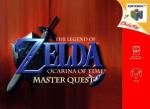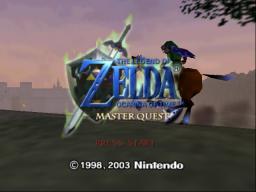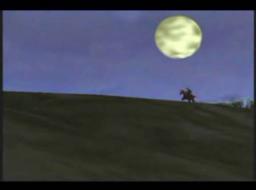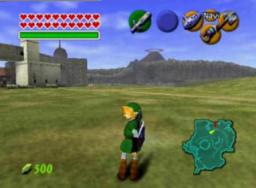Forum Links
Thread Information
Thread Actions
Order
Ocarina of Time: Master Quest
Game's Ratings
Overall
Graphics
Sound
Addictiveness
Depth
Story
Difficulty
Average User Score
9.4
8.9
9.3
9.9
9.3
9.6
7.9
10-18-13 02:17 PM
star4z is Offline
| ID: 908614 | 2076 Words
| ID: 908614 | 2076 Words
star4z
Level: 26





POSTS: 93/127
POST EXP: 13279
LVL EXP: 95122
CP: 906.9
VIZ: 47287

POSTS: 93/127
POST EXP: 13279
LVL EXP: 95122
CP: 906.9
VIZ: 47287

Likes: 0 Dislikes: 0
Background Information After the release of the original Ocarina of Time, rumors were circulating about two new titles for the N64 DD: Ura Zelda and Zelda Gaiden. The N64 DD failed as a system, but Zelda Gaiden was still released as a standalone title: The Legend of Zelda: Majora’s Mask. However, Ura Zelda was never released. In theory. However, when Zelda’s Gamecube release came around, The Legend of Zelda: The Wind Waker, a pre-order special included an extra disk with Ocarina of Time, and a previously unreleased title, Master Quest, which included improved graphics, and harder puzzles. A look at the Japanese version showed that it was entitled, “Ura Zelda.” There are problems with this being of the promised game, but the official word from Nintendo is that Master Quest is Ura Zelda. The problems fans have with the idea is that the rom ripped from the Gamecube disc that forms the Master Quest N64 rom would fit on a normal N64 cartridge, while Zelda Ura was supposed to go above and beyond the normal Ocarina of Time. I think maybe this is because they didn’t finish programming the Master Quest beyond what was necessary for the Gamecube release because they were not going to release the game originally. Graphics The graphics of the Master Quest are improved from that of the of the original, but not to a great extent. The graphics are the most noticeably different in the UI, such as the health meter, and the opening title logo. Apart from being a re-release, the textures are pretty good. The textures look good on smaller objects, but they often look stretched or very repetitive on larger areas, a result on the small amount of space the Nintendo 64 allowed for textures on a cartridge. I think that all the characters in the game look somewhat realistic (as far as they are supposed to be), but I found Ganondorf’s head too skinny, and the eyes on adult Link’s head were too close together. Otherwise, the textures were amazing. The character models for the game are better than usual for the Nintendo 64/ Playstation One generation, but they still are easily defined as polygonal. Gameplay Not unexpectedly, the gameplay of the Master Quest is almost identical to the original. You use the main stick to walk around, the C buttons to conduct the ocarina, as well as up on the C stick give you first person view. The Z trigger centers the camera on you or tracks an enemy. The other three directions on the C buttons allow you to use items, which are assigned in the pause menu. The A button is the action button, and the B button is the sword button. When you need to jump a gap, you auto-jump (meaning your character does it on his own, you don’t need a button). You break a pot or cut some grass, you get rupees or a heart. You lock on something, you can jump back, slash attack it, jump attack it, et cetera. You walk up to wall of vines, you begin to climb it. You reach a ledge about shoulder height. Difficulty While the Master Quest is very much like the original Ocarina of Time, at the same time it is very different. The more difficult gameplay is what separates this game from the original. Harder enemies are introduced much earlier in the game, which means you have to work more on you fighting skills a lot more. Also, the puzzles in the game are much, much more complex. All of the dungeons have been redone to be much harder, to the extent that rooms in the Master Quest are completely unrecognizable from their original forms in the non-disc drive release. The Master Quest takes tons of thought to finish, making it one of the hardest puzzle games ever. (I’m not saying this game is the best puzzle game ever, or the hardest puzzle game ever, but it’s pretty hard for the adventure genre.) For example, in Jabu-Jabu’s belly, the basic puzzle is shooting the cow heads on the wall with the slingshot. But then, in the room right before the big boss of the dungeon (Barinade), you see a couple cow heads on either side of the room. Shooting the one on the left leads to a treasure chest dropping by the door, but you still can’t go through the door. Shooting the one on the right apparently does nothing. However, what you’re supposed to do is shoot the cow’s head on the right four times. What I didn’t notice the first four or so times was that the cow’s head moved up about a virtual foot each time you shot at it. In the original, all you had to do was throw your boomerang at a switch, or put a box on the switch. Mini Games In Ocarina of Time, there is a lot of mini games that you can spend your time performing in the free time you wouldn’t actually have if you were trying to save a nation in trouble, but that’s beside the point. The point is that you can play a lot of mini games to earn objects that will help you in your quest for getting everything in the game or replenishing your supplies, such as a shield, because you were being such a noob, and weren’t cutting all of the grass and pots, or got your shield on fire. Anyways, these games are a fun way to let off steam, like the bombchu bowling alley, the Zora’s rupee dive, shooting gallery, fishing, and jam session with the Skull kids. Sound: Music Oh my goodness, this is my favorite part. The music from Ocarina of Time just blows me away. (The Master Quest has exactly the same music as the original Ocarina of Time.) The music of Kokiri Forest makes me feel like I’m in a small, wooden village where I can run around with my friends and have fun all the time, and not be the least bit afraid of danger. Hyrule Field makes me think of a large area with lots to explore (unfortunately, this isn’t as true as I wish it was), where there is danger, but I can easily overcome it. Zora’s Domain reminds me of a tropical beach. (Specifically, Hawaii.) Lost Woods makes me feel like I’m casually strolling towards a destination, which makes running through black holes less boring. Temple of Time is reminiscent of a large cathedral with a high, arched ceiling and large stained glass windows. Classic Zelda songs make their appearances in Ocarina of Time as well, such as Zelda’s Lullaby. Also, the Title Theme is taken from the ocarina melody in the original Legend of Zelda for the Nintendo Entertainment System. Kakariko Village is very similar to the version found in A Link to the Past (for the Super Nintendo). Sound: Effects This game continues with the classic cheesy but funny Zelda sound effects. Hearing Link say, “hup!” every time he climbs a ledge, Link saying “Hiyah!” every time he does the spin move with the sword, and Navi saying “Hey!” is totally classic. This may sound perverted, but I even like Link’s suffocating death sound effect. The unspoken sound effects, such as pressing a switch, hitting your sword against some hard, and a deku nut exploding, are pretty good. I didn’t realize that some of the effects were orchestrated until I listened to the Skyward Sword soundtrack, in which they orchestrated those sound effects. The “You solved a puzzle!”, death, and open a treasure chest sound effects show Nintendo’s skill in these areas. 2D to 3D Ocarina of Time is the first game in The Legend of Zelda series that features three dimensions in game. (According to Nintendo, “A Link Between Worlds” for 3DS is the first three-dimensional game, but that’s 3D in a real life kind of way.) Ocarina of Time very smoothly converted the classic gameplay into a modern gameplay style that the series strictly stayed with, even up to Twilight Princess for Gamecube and Wii. Skyward Sword even follows the same style, but adds an entirely different form of control. The hookshot now becomes an object that can shoot at anything wooden and targets, and swing or grapple towards that project, but originally, in A Link to the Past, you could shoot it at enemies to stun or kill them, or if there was a pot or something of the sort on the ground that you could pick up if you were next to it, you could grapple to that. In A Link to the Past, you would see and eye of sorts across a gap, and you would have to shoot it with your arrows to open the path ahead. In Ocarina of Time, an eye would be hidden somewhere above the door, and you would have to aim and shoot it with your slingshot. Addictiveness The Master Quest is very addictive, as all Zelda games are, but it’s not as addictive as Wind Waker [GC] or Twilight Princess [GC, Wii]. Ocarina started the trends that newer Zelda games followed, especially in dungeon format and overworld. If I could, I would play this game forever. (Except during the Jabu-Jabu’s belly dungeon. That dungeon is painful to play through.) Side quests are pretty fun to do, too, like catching all the cuccos. However, exploring the town areas is my favorite activity, such a Kokiri Forest, Kakariko Village, Zora’s Domain, and Goron City. Story The story of Ocarina of Time is unchanged in the re-release. Ocarina of Time tells of a young boy who is chosen to be the Hero of Time. He grows up in a forest with other children under the care of the Great Deku Tree, but one day the Deku Tree has a vision of a forthcoming danger, and he sends the young boy, named Link, out on an adventure to save the land of Hyrule. Link goes to Hyrule Castle Town, the capital of Hyrule, where he meets Princess Zelda, who also believes that there is an eminent danger, and she believes it is in the form of the demon thief, Ganondorf. She tasks him with collecting the three Spiritual Stones, which would allow him to retrieve the Master Sword from its pedestal in the Temple of Time, one of which he has already received from the Deku Tree. He collects the second stone from the Goron in Death Mountain, and the third gem from the Zora in their domain. He heads back to see Zelda, but finds them fleeing Hyrule Castle, with Ganondorf on their tail. Zelda throws the Ocarina of Time into the moat, and Link picks it up and heads into the Temple of Time. Link plays the Song of Time and places the three stones in their respective places, and the door to the Master Sword and the sacred realm opens. Ganondorf, however, has followed Link, and he goes into the sacred realm, where the Triforce is. Link is then sealed in the Temple of Time for seven years. When he awakes, Ganondorf has Hyrule under his control. He is greeted by Sheik, a member of the Sheikah tribe, who helps him in his quest. He goes into all the temples to wake up the sages, so that he can seal Ganondorf away. He then continues to do so, but when he has awoken all the sages, he has to fight Ganondorf. After initially defeating Ganondorf, Ganondorf transform into the beast-like Ganon. Link then defeats him, and Ganondorf is sealed away. Link is then transported back to his own time by Zelda, where he prevents Ganondorf’s rise to power, and is not remembered for his heroism, except by Zelda. This story made me think about how determined Link was to save his kingdom, that he left his home and went out into a large new world, and eventually destroyed the threat to society, without receiving much praise back in his own time. Size Ocarina of Time is very vast. Hyrule Field alone is very vast. The dungeons may not be very big, but the game is pretty large for its time. The amount of individual areas you can go to is a pretty good sized number. There is a good amount of side quests in each area, so you are always going back to an area you already visited to get more stuff. |
Member
Affected by 'Laziness Syndrome'
Registered: 06-22-13
Last Post: 3315 days
Last Active: 1495 days
Affected by 'Laziness Syndrome'
Registered: 06-22-13
Last Post: 3315 days
Last Active: 1495 days


 User Notice
User Notice 






